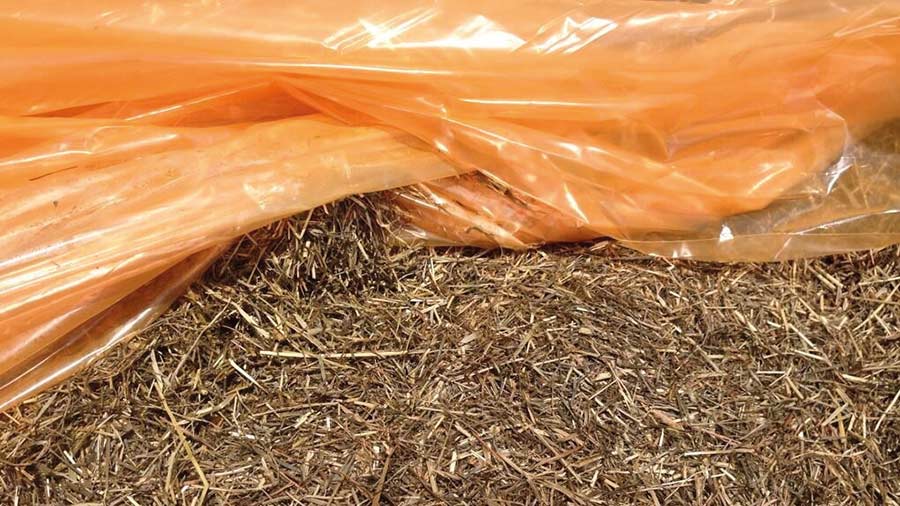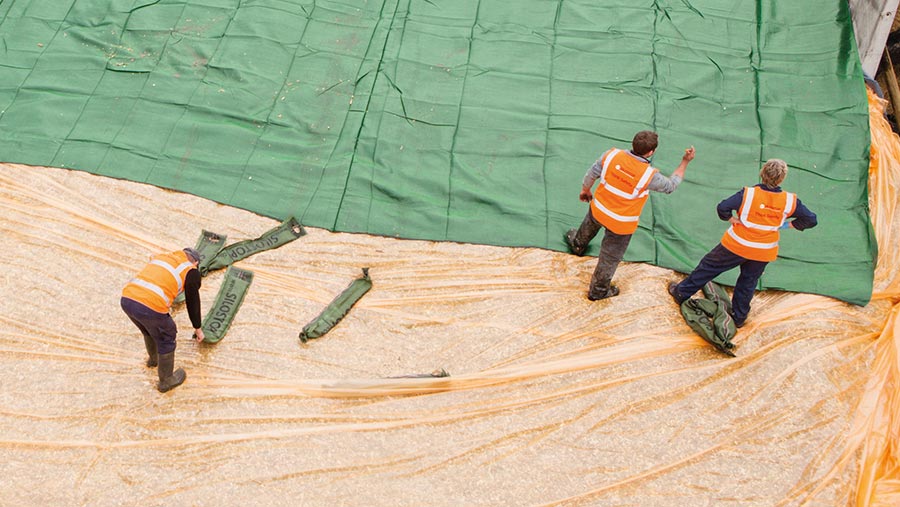How to cut silage spoilage and on-farm plastic use with HOB film
 © Silostop
© Silostop Opting for high-oxygen barrier (HOB) films instead of black plastic sheets has been shown to reduce silage clamp losses from 15% to 7%.
This could go some way towards protecting farmers against rising feed costs.
HOB sheets are thin, polymer films that cling to the top of the clamp, with the aim of eliminating air pockets.
They are made using less plastic than conventional black sheets – which are often applied in a double layer – and can be used with just an ultraviolet (UV) net on top, plus weighting.
See also: 3 ways a farmer is optimising silage management to cut costs
HOB sheets cling to the top of the clamp in a similar way to conventional “cling film” sheets, but do not require an additional black plastic layer on top.
Manufacturers also claim they reduce silage losses by limiting oxygen penetration. This facilitates rapid fermentation and prevents air ingress, which in turn avoids the formation of mould.
Tim Brewer of silage protection specialist Silostop explains: “A proper high-oxygen barrier will have an oxygen transmission rate of less than 5cu cm/sq m of film. This means almost no air can get into the clamp in use.
“With typical black silage plastic this [rate] is more like 300cu cm/sq m.”
In a conventional cling film, he says oxygen transmission can reach 1,000cu cm/ sq m in 24 hours.
“These thin, transparent polyethylene [cling] films can appear to give a reasonable result, with a visual reduction in top layer spoilage. But their extremely high oxygen transmission rate results in high dry matter losses,” he says.
Trial work at the French National Institute for Agricultural Research (Inra) has shown significant reductions in silage waste from 15% to 7% when switching from black sheets to HOB films.
Butyric acid concentrations were also higher in the clamp covered with black plastic, indicating poorer fermentation.
Cost savings
Farms in the UK have demonstrated bigger reductions in waste, from 15% to 5%. Independent dairy nutritionist Martin Attwell believes such improvements represent huge cost savings.
For example, in a clamp with 600t dry matter (DM) of silage at 30% DM, reducing waste from 15% to 5% would result in an extra 60t DM of silage, he says.
Silage of 11.5MJ metabolisable energy (ME)/kg will yield 11,500MJ ME for every tonne of DM. If 90% of that energy makes it from clamp to cow, that’s 10,350MJ ME.

Orange high-oxygen barrier film with reuseable anti-UV cover © Silostop
If 5.3MJ ME is needed to produce a litre of milk, this would potentially produce 1,950 litres of milk. And 60t DM would produce an extra 117,000 litres.
“At 40p/litre of milk, that’s more than £46,000 of extra milk revenue. Or, if you want to look at it another way, each 1t DM lost would need 0.75t of concentrate to replace it.
“So, if you can save 60t DM of clamp loss, you’ll be saving on 45t of extra concentrate. At £350/t, that’s a saving of almost £16,000,” Mr Attwell explains.
Moving to HOB film could also help farmers lower their environmental impact and plastic use.
For example, covering forage maize with a single layer of HOB film has been shown to give large reductions in primary energy and greenhouse gases compared with covering clamps using two layers of standard, thicker film (see below).
Benefits
- -42%
Reduction in waste on the top layer of clamps sealed with a HOB film, compared with a black plastic sheet (meta-analysis of >50 pieces of work, University of Nottingham) - >15%
Total silage losses on a clamp with traditional black plastic film compared with 7% when using HOB film (Inra)
Studies at Wageningen UR Livestock Research showed:
- -82%
Reduction in the total weight of plastic used when using a HOB film versus a standard black plastic sheet - <20%
Difference in energy needed to produce a HOB film compared with a standard black plastic sheet - >5.5 times
The amount of greenhouse gases produced in the manufacture of standard black plastic sheet compared with HOB film
Tips for making the most of HOB film
- Select the right size of film for the silage clamp and limit the number of joins to avoid air ingress
- Use a genuine HOB – check by asking questions about oxygen transmission rates
- Manage films correctly: choose a stronger film and secure cover if clamps are repeatedly being filled. A lighter sheet with an ultraviolet cover is sufficient for a clamp that is filled and left
- Use side sheets with a HOB top sheet to reduce the risk of oxygen penetration
- Follow silage-making best practice. In particular, pay attention to consolidation and weighting across the clamp. Arrange sandbags in a 5m grid pattern with a double row around the edges. Always sheet up every evening at harvest
Case study: Bartletts and Southey Farm, Ilminster, Somerset
Farm facts
- Partnership between Mark Humphry, his wife, Belinda, and son, Matt
- Tenants of the Duchy of Cornwall
- 263ha (650 acres)
- 364 cows yielding 8,200 litres a cow a year at 4.54% fat and 3.65% protein
- 3,750 litres milk a cow a year from forage
- Autumn block-calving – end of August to end of November
- Three-way cross: Holstein cross Norwegian Red cross Fleckvieh
Using a high-oxygen barrier (HOB) film has eliminated top waste on the maize silage clamp, made sheeting up “a breeze” and cut plastic use in half at Mark Humphry’s dairy farm.
“I’d say we’re down to zero waste compared with an inch of waste on the top [previously]. It’s not just the quantity but the hassle factor of taking off that contaminated feed,” says Mr Humphry.
Two years ago, he decided to try using a HOB film and anti-UV cover instead of “cling film”, conventional black plastic sheet and green netting.
Although initially sceptical that such a light sheet would be strong enough to avoid tearing and do the job without an additional black sheet, the system has proved its worth.
The maize clamp has side sheets, an HOB film, UV cover and tyre walls or gravel bags on the seams in a box pattern across the clamp.
Mr Humphry found using less plastic sped up the sheeting process and meant the team were more likely to sheet up at night after a long day of silage-making.
He estimates silage losses on the previous system equated to about 1% or 7.5t on the 750t maize clamp.
As the spoiled silage had to be taken off and disposed of, and good silage would also have been removed in the process, he believes the total waste could have been two or three times that.
Less spoilage has also improved ration palatability and dry matter intakes.
The new system uses about 300kg of plastic, about half that used on the grass silage clamps, where the old system is still used.
With recycling costs of £220/t last year and environmental pressures to reduce plastic use, the plan is to move the grass clamps over to the same system as the green nets wear out and need replacing.
